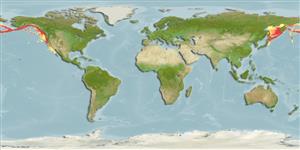Environment: milieu / climate zone / depth range / distribution range
экология
морской батидемерсальный; мигрирует в океане (Ref. 51243); пределы глубины 175 - 2740 m (Ref. 6793), usually 175 - 1450 m (Ref. 10935). Deep-water; 64°N - 23°N, 141°E - 109°W
North Pacific: Bering Sea coasts of Kamchatka, Russia and Alaska southward to Hatsu Shima Island, southern Japan and Cedros Island, central Baja California, Mexico in the eastern Pacific.
Length at first maturity / Size / Вес / Возраст
Maturity: Lm 60.3, range 58 - 62 cm
Max length : 120 cm TL самец/пол неопределен; (Ref. 9988); common length : 80.0 cm TL самец/пол неопределен; (Ref. 9988); наибольший возраст (опубликованны данные): 94 годы (Ref. 55701)
Краткое описание
определительные ключи | морфология | морфометрия
колючие лучи спинного плавника (общее число) : 19 - 27; членистые (мягкие) лучи спинного плавника (общее число) : 16 - 20; колючие лучи анального плавника: 3; членистые (мягкие) лучи анального плавника: 15 - 19. Dorsal fins well separated; 2nd dorsal fin sub equal to anal fin in size and form, and opposite in position. Reaches over 1 m in SL.
Adults found on mud bottoms, from 305 (Ref. 2850) to 2,740 m depth (Ref. 2850). Young-of-the-year juveniles are pelagic and found on the surface and near-shore waters (Ref. 28499). Generally localized, but some juveniles have been found to migrate over 2,000 miles in 6 or 7 years (Ref. 28499). Feed on crustaceans, worms and small fishes (Ref. 4925). Most of the catch is marketed in Japan (Ref. 28499). Utilized fresh, dried or salted and smoked (Ref. 9988), can be steamed, pan-fried, broiled, boiled, microwaved and baked (Ref. 9988). The liver oil is rich in vitamin A and D (Ref. 4925). Reported to reach 57 kg in Ref. 2850.
Eschmeyer, W.N., E.S. Herald and H. Hammann, 1983. A field guide to Pacific coast fishes of North America. Boston (MA, USA): Houghton Mifflin Company. xii+336 p. (Ref. 2850)
Статус Красного Списка МСОП (Ref. 130435: Version 2024-2)
Угроза для людей
Harmless
Использование человеком
рыболовство: важный объект промысла; аквакультура (рыбоводство): предсказание будущего; объект спортивного рыболовства: да; аквариум: общественные аквариумы
дополнительная информация
инструменты
Специальные отчеты
Скачать в формате XML
ресурсы в Интернет
Estimates based on models
Preferred temperature (Ref.
123201): 1.4 - 5.5, mean 2.5 °C (based on 599 cells).
Phylogenetic diversity index (Ref.
82804): PD
50 = 1.2500 [Uniqueness, from 0.5 = low to 2.0 = high].
Bayesian length-weight: a=0.01122 (0.00806 - 0.01563), b=2.98 (2.88 - 3.08), in cm total length, based on LWR estimates for this species (Ref.
93245).
Trophic level (Ref.
69278): 3.8 ±0.2 se; based on diet studies.
Generation time: 5.8 (4.9 - 7.8) years. Estimated as median ln(3)/K based on 23
growth studies.
устойчивость к внешним воздействиям (Ref.
120179): очень низкий, минимальное время удвоения популяции более 14 лет (K=0.2; tm=6; Fec=100,000; tmax=94).
Prior r = 0.11, 95% CL = 0.07 - 0.16, Based on 10 full stock assessments.
Fishing Vulnerability (Ref.
59153): Moderate to high vulnerability (49 of 100).
Climate Vulnerability (Ref.
125649): High vulnerability (58 of 100).
Nutrients (Ref.
124155): Calcium = 16.1 [9.1, 38.6] mg/100g; Iron = 0.46 [0.23, 0.90] mg/100g; Protein = 17 [16, 18] %; Omega3 = 0.567 [0.254, 1.631] g/100g; Selenium = 32.5 [14.5, 79.2] μg/100g; VitaminA = 8.27 [1.99, 36.01] μg/100g; Zinc = 0.27 [0.18, 0.42] mg/100g (wet weight);
